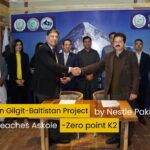GILGIT:“In the last 24 hours, the temperature at the K2 Base camp fluctuated between -1 and 6.9 degrees centigrade; wind flow at 13km/h. It is relatively hot at the K2 base camp, wind is strong and relative humidity low: 27% minimum, 75% maximum. This is the first data received in real time from K2.”
HunzaNews, July 2nd, 2014.
Thanks to a meteorological station set up at the base camp of Pakistan’s highest peak in Gilgit-Baltistan (G-B), scientists can now monitor changes in weather in real time.
The station has been installed 4,970 metres above sea level (MASL), directly on the glacier near the base camp where members of the ‘K2 60 years later’ expedition have already reached.
The initiative has been taken by the integrated Stations at High Altitude for Research on the Environment (SHARE) project. SHARE is funded by Ev-K2-CNR, an Italian mission promoting scientific and technological research in mountainous areas, particularly the Hindu Kush, Karakoram and Himalaya region.
“It is the highest met station ever in the Karakoram, comprising an international climate and atmospheric monitoring network, research in environmental and geophysical sciences and new technology development for monitoring activity in high mountain regions,” added the email sent by the Ev-K2-CNR office on Monday, which also relayed the data mentioned above.
Ev-K2-CNR Technical Representative in G-B, Arif Hussain, is hopeful the installation will help collect scientific data to better deal with issues relating to climate change. “It will help us get real-time data which will go a long way in dealing with climate change issues,” Hussain told The Express Tribune on Tuesday.
High specs
The station has been designed and provided by CAE System – a company which designs, installs and maintains Multi-Hazard Monitoring and Early Warning Systems. It has been put together using a modular structure, which can be disassembled into parts, to simplify the cumbersome transportation process via a long trek along the Baltoro Glacier.
The met station has been provided with four sensors: ananemometer, thermoigrometer, barometer, and an albedometer. Together they measure wind speed and direction, temperature, humidity, snow levels and solar irradiation. These sensors are able to transmit data automatically and in real time to the researchers.
“To transport the station on the Baltoro Glacier has not been easy – even if we had used animals,” said Marcello Alborghetti, an Ev-K2-CNR researcher and technician.
“We worked hard and quickly with Madi, our Pakistani technician, to install the station and to calibrate all the sensors. The most difficult and complex aspect was the communication system and the real-time data connection,” Alborghetti added.
Under the guidance of Marcello Alborghetti and Madi, the Pakistanis and Italians at the K2 base camp, worked together to reach this important scientific goal.
“This meteorological station at the K2 Base Camp is the fourth SHARE station located in the Baltoro area,” said Elisa Vuillermoz, the Ev-K2-CNR scientific coordinator. “The data provided by this new station will add to all climatic data and information that we have about the Central Karakoram area.”
Vuillermoz added, “The monitoring of this peculiar area is also important for the comprehension of the Karakorum anomaly phenomena that highlights stability or a small rise of the glaciers, which is contrary to the phenomena registered in the Himalayan region, where glaciers are regressing.”
The station will continue to send real-time data during the ‘K2 60 years later’ expedition whose nine members have reached camp one. The two Italian mountaineers, Michele Cucchi and Simone Origone, and four Pakistanis are trying to reach camp two in spite of poor weather conditions.
Express Tribune

























